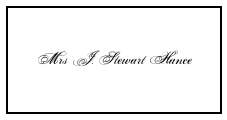The custom of carrying calling cards began in
France in the early 1800's, spreading quickly throughout Europe before
becoming vastly popular in the United States. Calling cards were
carried by the "well-to-do" ladies who made a point to 'go calling' on
friends and family on a specified day of the week or month, depending
on their location and proximity to neighbors. When visiting friends, or
'making calls,' a card would be left in a card receiver at the front
door or parlor, even if the person they were visiting was home. Calling
card receivers (trays) were set out on marble top entry tables.  The
trays were usually silver or silver plate and had a rich, ornate
design. Cards were carried in a variety of finely crafted cases made of
sterling, mother of pearl, tortoiseshell, velvet, ivory, and more. The
trays were usually silver or silver plate and had a rich, ornate
design. Cards were carried in a variety of finely crafted cases made of
sterling, mother of pearl, tortoiseshell, velvet, ivory, and more.
Hundreds of thousands of cards were printed from
1800 through the 1890's. The lady's card was larger in size than the
small breast pocket size carried by gentlemen. Styles evolved from
hand-penned cards to simple print, then hidden name, and even tiny
envelope insert cards.Sometimes a loving greeting was added, though the
card alone was considered a message.
It was considered a "red-letter day," a term that
originated with the tradition of marking holy days in a church calendar
in red, when a young 'maid' or man was granted his or her first
visiting card. As for babies whose cards were sent out by their
parents, theirs was 'the tiniest and daintiest of cards, fit for
fairies!' according to one Victorian Lady, Margaret Sangster, in her
etiquette book entitled Good Manners For All Occasions.
The fashions of calling cards varied with the
trends; sometimes middle initials were fashionable, other times not;
some cards were ornate, while others were of a "severe style,"
particularly for the gentlemen.
In the book Decorum, published
in 1877, the following recommendations were made for refined visiting
card etiquette: 'Visitors should furnish themselves with cards.
Gentlemen ought simply to put their cards into their pocket, but ladies
may carry them in a small elegant portfolio, called a card-case. This
they can hold in their hand and it will contribute essentially (with an
elegant handkerchief of embroidered cambric) to give an air of good
taste.'
|

